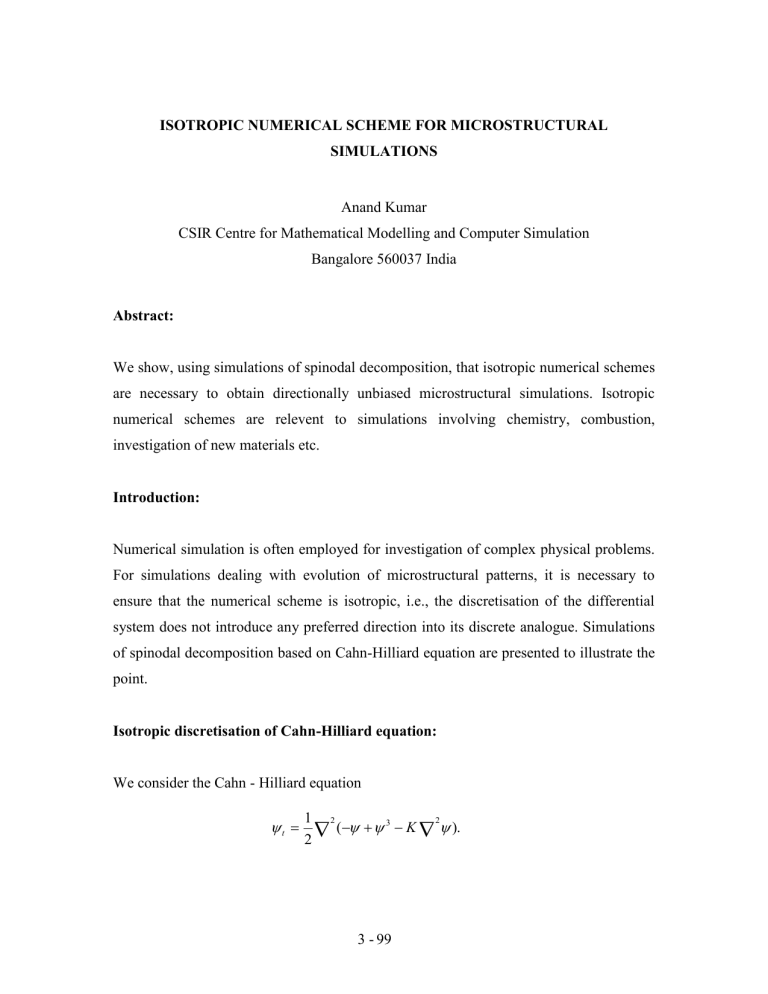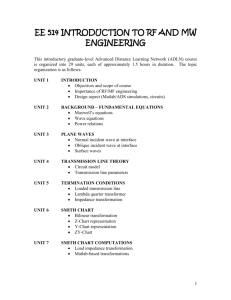We need to consider the discretisation of the Laplacian for its

ISOTROPIC NUMERICAL SCHEME FOR MICROSTRUCTURAL
SIMULATIONS
Anand Kumar
CSIR Centre for Mathematical Modelling and Computer Simulation
Bangalore 560037 India
Abstract:
We show, using simulations of spinodal decomposition, that isotropic numerical schemes are necessary to obtain directionally unbiased microstructural simulations. Isotropic numerical schemes are relevent to simulations involving chemistry, combustion, investigation of new materials etc.
Introduction:
Numerical simulation is often employed for investigation of complex physical problems.
For simulations dealing with evolution of microstructural patterns, it is necessary to ensure that the numerical scheme is isotropic, i.e., the discretisation of the differential system does not introduce any preferred direction into its discrete analogue. Simulations of spinodal decomposition based on Cahn-Hilliard equation are presented to illustrate the point.
Isotropic discretisation of Cahn-Hilliard equation:
We consider the Cahn - Hilliard equation
t
1
2
2
(
3
K
2
).
3 - 99
We need to consider the discretisation of the Laplacian for its simulation. This for the conventional scheme is written as
2
i , j , k
i
1 , j , k
i
1 , j , k
i , j
1 k
i , j
1 , k
i , j , k
1
i , j , k
1
6
i , j , k
h
2
, where h is the step size. We note that the leading discretisation error in the above is h
2
12
xxxx
yyyy
zzzz
.
We also consider the following discretisation of the Laplacian
2
i , j , k
5
12
i
1 , j , k
1
8
i
1 , j
1 , k
i
1 , j , k
i , j
1 , k
i
1 , j
1 , k
i , j
1 , k
i
1 , j
1 , k
i , j , k
1
i , j , k
1
i
1 , j
1 , k
i , j
1 , k
1
i , j
1 , k
1
i , j
1 , k
1
i , j
1 , k
1
i
1 , j , k
1
i
1 , j , k
1
i
1 , j , k
1
i
1 , j , k
1
1
48
i
1 , j
1 , k
1
i
1 , j
1 , k
1
i
1 , j
1 , k
1
i
1 , j
1 , k
1
i
1 , j
1 , k
1
i
1 , j
1 , k
1
i
1 , j
1 , k
1
i
1 , j
1 , k
1
25
6 i , j , k h
2
The leading discretisation error in the above is
3 - 100
h 2
12
4
, which is direction independent. We refer to the scheme based on the above discretisation of the Laplacian to be isotropic.
Results:
We first consider simulations of spinodal decomposition for a deep quench starting from a single point. We take K=0.346
in all the simulations reported here. Simulations are carried out on a 100x100x100 grid, with h=1 , and
t = 0.05 for the isotropic scheme, and
0.01 for the conventional scheme. Fig.1 compares the phase patterns using the present isotropic scheme, and the conventional scheme, on (0,0,1) -plane and (1/
2,-1/
2,0)-plane through the centre of the quench. The expected spherical phase pattern is found to be well captured by the isotropic scheme; the conventional scheme, however, gives a phase pattern which is less spherical.
Simulations of spinodal decomposition from a randomly generated arbitrary initial condition are compared in Figs.2-3. A 64x64x64 grid, with h=1 is taken, and periodic boundary conditions are employed. While the simulations from the two schemes are fairly similar at small times (Fig.2), the phase pattern from the two simulations are seen to differ considerably at later times (Fig.3).
We also assess the effect of increasing the number of grid points, called, grid refinement, on the simulations. A finer grid of 128x128x128 cells, with h=0.5
is considered. A randomly generated initial condition on this grid is taken. The grid refinement is found to improve the comparison between the two simulations at small times. However, the phase patterns at later times, shown in Fig.4, differ, though less pronouncedly ( cf. Fig.3
).
3 - 101
Conclusions:
In the microstructural simulations, small differences in the microstructure can lead to larger differences at later times. If the computational scheme is not isotropic, features due to numerical anisotropy, can become prominent at later times. Grid refinement only delays the variations in the isotropic and non-isotropic simulations. Isotropic numerical schemes are therefore necessary to provide directionally unbiased microstructural simulation, without incurring a high computational cost. Isotropic numerical schemes are relevant to simulations, such as simulations involving chemistry, combustion, investigation of new materials etc.
3 - 102
3 - 103
3 - 104
3 - 105


